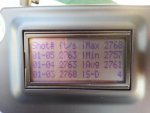Hey, all. I have been having a problem with inconsistent velocities and can't pinpoint what is causing it. Maybe you guys can help.
I shot these three 5-shot groups today, and here are the velocities for each string:
#1 2674, 2635, 2650, 2645, 2609
#2 2679, 2629, 2640, 2640, 2645
#3 2629, 2650, 2656, 2609, 2635
Of course I was seeing some vertical stringing and some errant shots that were not flyers by were off the group by a bit. Average group size was about 1.5" because of the inconsistency of the loads. This has been a .5" or better rifle up until now, and this load has proved most accurate up until now.
Load data: 42.2 grains of IMR 4046, CCI-200 primers, Lapua cases full-length sized to 2.005", 175 SMKs seated to COAL of 2.803" give or take a thousandth or two.
Rifle: Savage 24" 5R heavy contour barrel in .308. Copper cleaned about 100 rounds ago. Only 475 total rounds through the rifle.
I am very meticulous when I reload. No step is skipped or missed. I full length resize. I uniform the primer pockets. I deburr the flash holes if needed. I trim all brass to 2.005" using a Lee case trimmer tool. I deburr the case mouth. I then tumble the brass and check to make sure the inside is clean and free of debris. I then prime using a Lee hand priming tool. I measure out the powder a little low, then trickle to 42.2 grains on a Hornady Lock n' Load 1500 digital scale. I double check about every 5th charge on a Lee beam scale, and they have never differed from each other. I mean, they are both dead on, and I measure on a solid, flat surface, of course. I weigh all cases and group in similar weights, then I seat the 175 SMKs with a Lee bullet seating die. No crimp. Done.
Velocity was measured with a ProChrono Digital on a 63ºF sunny day. Chrono was set up properly with both sensors in the sun.
Here is the thing. I know chronos can be inconsistent, but the velocities were matching up with the point of impact. High velocity shots were impacting high, and vice versa. So I am inclined to think the chrono is fine. A buddy of mine shoots over the same chrono and gets awesome consistency with his loads, like 10 fps or less.
It's pretty irritating because this was a .5" rifle or better at 100 yards, but something happened and now my loads are not very consistent.
So, what can cause these velocity variances besides the obvious stuff like inconsistent powder charges and inconsistent seating depth?
The only thing I can think of is bad primers causing inconsistent ignition or inconsistent neck tension somehow, but I am not sure how much neck tension affects velocity.
What say you all?
I shot these three 5-shot groups today, and here are the velocities for each string:
#1 2674, 2635, 2650, 2645, 2609
#2 2679, 2629, 2640, 2640, 2645
#3 2629, 2650, 2656, 2609, 2635
Of course I was seeing some vertical stringing and some errant shots that were not flyers by were off the group by a bit. Average group size was about 1.5" because of the inconsistency of the loads. This has been a .5" or better rifle up until now, and this load has proved most accurate up until now.
Load data: 42.2 grains of IMR 4046, CCI-200 primers, Lapua cases full-length sized to 2.005", 175 SMKs seated to COAL of 2.803" give or take a thousandth or two.
Rifle: Savage 24" 5R heavy contour barrel in .308. Copper cleaned about 100 rounds ago. Only 475 total rounds through the rifle.
I am very meticulous when I reload. No step is skipped or missed. I full length resize. I uniform the primer pockets. I deburr the flash holes if needed. I trim all brass to 2.005" using a Lee case trimmer tool. I deburr the case mouth. I then tumble the brass and check to make sure the inside is clean and free of debris. I then prime using a Lee hand priming tool. I measure out the powder a little low, then trickle to 42.2 grains on a Hornady Lock n' Load 1500 digital scale. I double check about every 5th charge on a Lee beam scale, and they have never differed from each other. I mean, they are both dead on, and I measure on a solid, flat surface, of course. I weigh all cases and group in similar weights, then I seat the 175 SMKs with a Lee bullet seating die. No crimp. Done.
Velocity was measured with a ProChrono Digital on a 63ºF sunny day. Chrono was set up properly with both sensors in the sun.
Here is the thing. I know chronos can be inconsistent, but the velocities were matching up with the point of impact. High velocity shots were impacting high, and vice versa. So I am inclined to think the chrono is fine. A buddy of mine shoots over the same chrono and gets awesome consistency with his loads, like 10 fps or less.
It's pretty irritating because this was a .5" rifle or better at 100 yards, but something happened and now my loads are not very consistent.
So, what can cause these velocity variances besides the obvious stuff like inconsistent powder charges and inconsistent seating depth?
The only thing I can think of is bad primers causing inconsistent ignition or inconsistent neck tension somehow, but I am not sure how much neck tension affects velocity.
What say you all?
Last edited:


